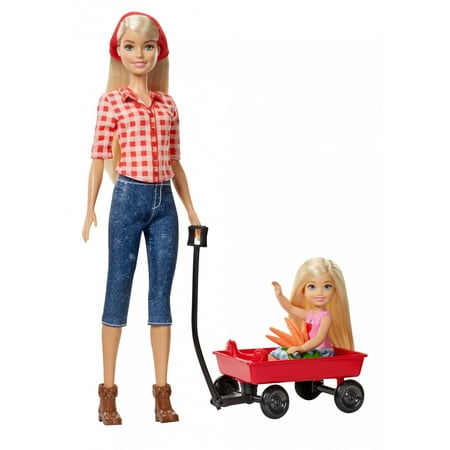Sweet Orchard Farm Playset, Barbie Doll and Chelsea Doll, with Red Wagon and Carrots
On Barbie Sweet Orchard Farm, everyone is welcome to lend a helping hand — it makes the work easier and the stories more fun! Kids can role-play a day on the farm with a farm doll set that comes with two dolls, a wagon and carrots. The two sisters are ready to help with harvest! The red wagon has wheels that really roll, and a handle that for a doll’s arm. Place the carrots, Chelsea doll or even Barbie doll inside — there are endless ways to get a story rolling. Barbie doll and Chelsea doll both wear outfits for a day harvesting veggies. And a bunch of carrots — with a leafy handle that fits in Chelsea doll’s hand — plants the seed for all kinds of tales! Collect all the Barbie farm dolls and toys because when a girl plays with Barbie, she imagines everything she can become (each sold separately, subject to availability). Includes Barbie doll wearing fashions and shoes, Chelsea doll wearing fashions and shoes, wagon with rolling wheels and a bunch of carrots. Barbie doll cannot stand on her own. Colors and decorations may vary.








Sweet Orchard Farm Playset, Barbie Doll and Chelsea Doll, with Red Wagon and Carrots:Age Range: 3 Years and UpIt’s harvest time on Sweet Orchard Farm — Barbie doll and Chelsea doll are ready to help with a red wagon and a bunch of carrots!The red wagon has wheels that really roll, a handle for a doll’s arm and room to carry the carrots, Chelsea doll or even Barbie doll!A bunch of carrots with a leafy top that fits Chelsea doll’s hand plants the seed for storytelling funBarbie doll is ready for a day on the farm wearing a red and white checked shirt, denim capris, brown boots and a red scarf in her hair; Chelsea doll has on a pink bodice with apple graphic, blue and white checked skirt and bright red welliesCollect all the Barbie farm dolls and toys because when a girl plays with Barbie, she imagines everything she can become!





Reviews
There are no reviews yet.